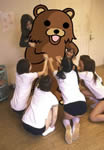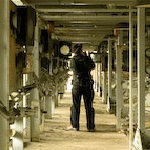http://www.replacements.com/mfghist/fostoriaglass.htm This site has more of the background before the move. It also states the furnaces closed in 1972. I am assuming the furnace was:
http://www.abandonedonline.com/index.php3?catid=113&thumboffset=1&thumb=500&image=http://www.abandone donline.com/content/113/photos/DSCN2679.jpg So how did the company operate without a furnace from 1972 to 1983?
Replacements, Ltd.
Fostoria Glass Company
Fostoria began as a glass-producing house in 1887. Initially, the factory was located in Fostoria, Ohio, but would only be located there a short time. Although the townspeople of Fostoria, Ohio had given their land to the glass company for free, Fostoria Glassworks was unable to remain because of a lack of natural resources. The promise of more abundant resources for producing glass caused the company’s leaders to make the decision to move. Within four years, Fostoria moved to Moundsville, WV. In 1891, the company built one furnace capable of firing 14 pieces, a remarkable achievement for the late 19th century glassworks industry. This furnace continued to produce glass until 1972.
By 1925, Fostoria’s factory had expanded to include five more furnaces. Primarily, the company produced decorative lamps and stemware pieces for the American home. Competing actively against Cambridge, Heisey, and Westmoreland Crystal, Fostoria would soon emerge as leader in the American glassware market. It is during this period that Fostoria began marketing lines of colored dinnerware and stemware pieces. The new products became an immediate success. The rise of industry throughout the 19th century had Americans turning away from afternoon teas and luncheons. Instead, these events quickly evolved into casual brunches and after work cocktail parties. The colored pieces were ideal for polished casual entertaining.
Throughout the 1930’s, Fostoria struggled to survive. The Great Depression had a notable impact on the luxury glassware market. Although many of Fostoria’s competitor’s would be forced out of business during the depression, innovative marketing techniques and business savvy managers would allow Fostoria to survive. The Second World War reduced Fostoria’s labor force by half and caused much of the company’s resources to be devoted to the war effort. Like many other companies throughout the United States, Fostoria weathered the hardships imposed by war. It is during the war period that Fostoria produced many of its most famous patterns including Chintz (1940), Colony (1940), Romance (1942), and Holly (1942).
Following the Second World War, Fostoria would begin its most aggressive expansion. Its labor force was increased to its prewar number, more natural resources were made available to the company, and the demand for casual and elegant dinnerware would increase to an all time high. New technologies developed during the war allowed Fostoria to create beautiful patterns that were easily maintained and added and air of elegance to any dining event. Throughout the 1950’s and 1960’s, Fostoria introduced more lines of beautiful crystal including Century (1950), Rose (1951), Wedding Ring (1953), and Jamestown (1959).
The company continued to do well through the 1960’s and 1970’s. A marketing strategy was developed by the company to create a consumer-producer relationship unlike any American company before. Boutiques and display rooms were built into many fashionable jewelry and department stores. Additionally, the company began publishing its own consumer direct magazine, “Creating with Crystal.” These and other marketing strategies kept Fostoria as a leader in the glass producing industry.
Throughout the 1970’s, foreign competition increased. Fostoria sold its stock and the Moundsville, WV factory to the Lancaster Colony Corporation. The managing directors of Lancaster Colony made the decision to close the factory and sell the remaining stock directly to consumers in 1983. The factory closed its doors and many of Fostoria’s original pieces and molds were sold. Throughout its history, Fostoria maintained a sound financial strategy, allowing them to expand and grow at will. Although Lancaster Colony closed Fostoria in 1983, Fostoria’s pieces are readily available through Replacements, Ltd. The Fostoria name is indicative of an American legend and Fostoria pieces remain highly collectible.







